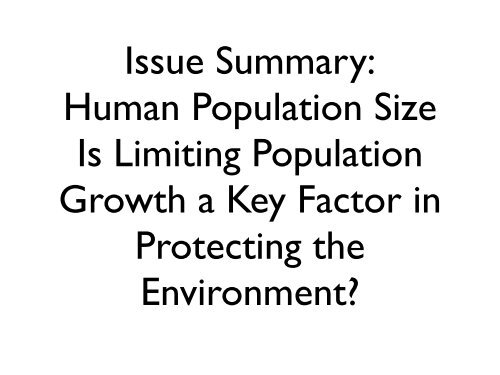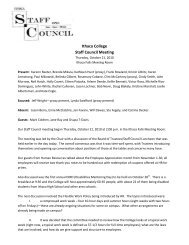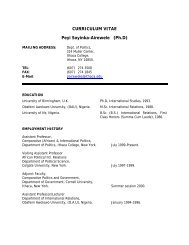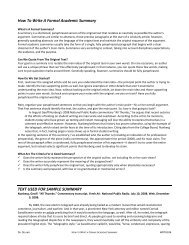Human Population Size Is Limiting Population Growth a Key Factor ...
Human Population Size Is Limiting Population Growth a Key Factor ...
Human Population Size Is Limiting Population Growth a Key Factor ...
Create successful ePaper yourself
Turn your PDF publications into a flip-book with our unique Google optimized e-Paper software.
<strong>Is</strong>sue Summary:<br />
<strong>Human</strong> <strong>Population</strong> <strong>Size</strong><br />
<strong>Is</strong> <strong>Limiting</strong> <strong>Population</strong><br />
<strong>Growth</strong> a <strong>Key</strong> <strong>Factor</strong> in<br />
Protecting the<br />
Environment?
Malthus' Essay on the<br />
Principle of <strong>Population</strong><br />
• points out that population size grows<br />
geometrically while agricultural production only<br />
grows arithmetically<br />
• Based on this, he says that population will<br />
eventually outstrip food supply<br />
• Eventually, the "demographic transition" of<br />
developed nations slowed population growth<br />
rates
<strong>Population</strong> <strong>Growth</strong> Policies were<br />
developed to slow population<br />
growth by:<br />
• economic aid<br />
• family planning aid<br />
• but neither has worked very well<br />
• UN Cairo Conference decided that better<br />
results would follow from improving women's<br />
access to education and health care
Should we be trying to slow<br />
population growth?<br />
• Ehrlich argues that unrestricted growth will lead<br />
to both human and environmental disaster<br />
• Some religious leaders oppose population control<br />
because they say family planning is against "God's<br />
will."<br />
• One might argue that there are various<br />
interpretations of "God's will". Which is<br />
"correct"?
By 2025, world<br />
population will<br />
probably be around<br />
8,000,000,000<br />
by 2050<br />
9,000,000,000
Global agricultural production<br />
has increased, but it has not<br />
kept up with rising demand<br />
• Other concerns are:<br />
• Loss of topsoil due to erosion<br />
• Depletion of aquifers<br />
• High cost of energy for making fertilizers<br />
•<br />
Modern Farming methods utilize a monoculture<br />
approach, this diminishes biodiversity and genes in<br />
our crops
Additionally, there are<br />
the problems of<br />
• Climate Change<br />
• air pollution<br />
• resource depletion<br />
• loss of species<br />
• collapse of fisheries
Yes --- Lester Brown<br />
• Argues that stabilizing world population is central to<br />
preventing overconsumption of environmental<br />
resources<br />
• Harvest trees, overgraze, etc. at rates that are faster<br />
than natural mechanisms can cope with
• Wackernagel et al. -- U.S National Academy of Sciences<br />
• <strong>Human</strong>'s demands exceeded earth's regenerative<br />
capacity by 20% in 1999<br />
• a "bubble econonmy" is going on with food<br />
production<br />
• UN Demographers -- in 2003, life expectancy in sub-<br />
Saharan Africa has gone from 62 to 47 years<br />
• HIV may claim more lives than all the wars of the<br />
20th Century
Environmental issues have mostly been<br />
local, but their effects won't be<br />
• Examples include<br />
• death of Aral Sea<br />
• burining rainforest in Indonesia<br />
• collapse of Cod fishery in Canada<br />
• melting glaciers that supply water to Andean<br />
cities<br />
• dust bowl forming in NW China<br />
• Depletion of Great Plains aquifer in US
No -- Stephen Moore<br />
• Argues that human numbers pose no<br />
threats to human survival or the<br />
environment but that efforts to control<br />
population do threaten human freedom and<br />
worth<br />
• Coercive Policies in China are the antithesis<br />
of <strong>Human</strong> Rights<br />
• Technology can provide us with what we<br />
need
• <strong>Population</strong> size is still increasing, but at<br />
lower rates . . .<br />
• People today are healthier than they’ve ever<br />
been before<br />
• We’ve enough land for everyone, we just<br />
need to be more efficient in using it<br />
• Malthus was wrong about population<br />
growth
Some Food for Thought<br />
Malthus may have been wrong about<br />
the date, but it is true that eventually<br />
carrying capacity of the planet will be<br />
exceeded by too many people.
Age Distribution of the World’s <strong>Population</strong><br />
<strong>Population</strong> Structures by Age and Sex, 2005<br />
Millions<br />
Less Developed<br />
Regions<br />
Age<br />
More Developed<br />
Regions<br />
Male Female<br />
80+<br />
75-79<br />
70-74<br />
65-69<br />
60-64<br />
55-59<br />
50-54<br />
45-49<br />
40-44<br />
35-39<br />
30-34<br />
25-29<br />
20-24<br />
17-19<br />
10-16<br />
5-9<br />
0-4<br />
Male Female<br />
-300 -200 -100 0 100 200 300<br />
-300 200 700<br />
Source: United Nations, World <strong>Population</strong> Prospects: The 2002 Revision (medium scenario), 2003.<br />
© 2005 <strong>Population</strong> Reference Bureau
Currently, we fail to provide the basic<br />
necessities for one out of every six people<br />
on the planet. If we cannot (or will not) do<br />
it today, why do we think we will be able to<br />
do so in the future when there will be 3.1<br />
billion more people by 2050?
Availability of Doctors, Selected Countries<br />
1995-2002*<br />
Physicians per 1,000 people<br />
Cuba<br />
5.3<br />
Greece<br />
4.4<br />
U.S.<br />
2.7<br />
Jordan<br />
Mexico<br />
China<br />
Bolivia<br />
1.7<br />
1.5<br />
1.4<br />
1.3<br />
Cambodia<br />
Bangladesh<br />
0.3<br />
0.2<br />
* Most recent year available for each country.<br />
Source: World Bank, World Development Indicators 2004.<br />
© 2005 <strong>Population</strong> Reference Bureau
Notes on Availability of Doctors, Selected Countries<br />
• <strong>Population</strong> growth can affect a country’s capacity to address the health needs<br />
of its people through trained personnel and accessible health facilities.<br />
• Access to health services varies greatly from country to country. In Greece,<br />
for example, there are 4.4 doctors for every 1,000 people.<br />
• This is over 17 times higher than in Bangladesh, which has only 0.2 doctors<br />
for every 1,000 people.<br />
© 2005 <strong>Population</strong> Reference Bureau
If we do not slow population growth, some<br />
argue, we are deciding by default to raise<br />
death rates for humans (already occurring<br />
in some parts of Africa) and greatly<br />
increasing environmental harm.
The US National Academy of Sciences and the<br />
Royal Society of London issued the following<br />
joint statement:<br />
``If current predictions of population growth and<br />
patterns of human activity on the planet remain<br />
unchanged, science and technology may not be<br />
able to prevent either irreversible degradation of<br />
the environment or continued poverty for much<br />
of the world.''
So, what do we do?<br />
• Most of the growth in human population<br />
size can be controlled via education of<br />
women and their partners (family planning)<br />
• As well as an examination of our goals,<br />
values, and long-term desires for humans on<br />
the planet
Family Planning<br />
• Family planning provides health and educational<br />
services that help couples choose how many<br />
children to have and when to have them. These<br />
programs vary, but most provide information on<br />
• 1) birth spacing,<br />
• 2) birth control, and<br />
• 3) health care for pregnant women and their<br />
infants.
• Advantages of family planning include:<br />
• Helping increase the proportion of<br />
married women in developing countries<br />
who use modern forms of contraception<br />
from 10% of married women in the 1960s<br />
to 54% in 2002.<br />
• Being responsible for at least 55% of the<br />
drop in TFR in developing countries. From<br />
6 in 1960 to 3.1 in 2002
• Reducing the number of legal and illegal<br />
abortions per year<br />
• Decreasing the risk of death during<br />
pregnancy.<br />
• Despite all this, 42% of all pregnancies in the<br />
developing world are unplanned and 26%<br />
end up in abortion
• An estimated 250--350 million women in<br />
developing countries want to limit the<br />
number and control the spacing of their<br />
children but they lack access to information<br />
and services.<br />
• According to the United Nations, providing<br />
this access and information could prevent<br />
and estimated 5.8 million births a year and<br />
more than 5 million abortions a year.
• There is a disconnect between the size of<br />
families women desire, and what they have.<br />
• Often, this is due to a lack of knowledge and<br />
resources about how to control family size
Desire for Smaller Families<br />
Women With Two Children Who Say They Want No More Children<br />
Percent<br />
60 59<br />
50<br />
52<br />
29<br />
38<br />
33<br />
29<br />
22<br />
13<br />
Bangladesh Egypt Guatemala Kenya Zimbabwe<br />
© 2005 <strong>Population</strong> Reference Bureau<br />
Late 1980s<br />
Late 1990s/Early 2000s<br />
Source: ORC Macro, Demographic and Health Surveys, 1988-2000.
How do we pay for family planning?<br />
• The United Nations posits that we could provide family<br />
planning to all the couples in developing countries that<br />
want it for about $17 Billion per year.<br />
• This does sound like a lot of money, however,<br />
• this equals about 8 days worth of worldwide military<br />
spending<br />
• Put another way: folks living in developed countries<br />
could easily pay about $4.80/year/person to reduce the<br />
world's population by about 3.1 Billion people.

















